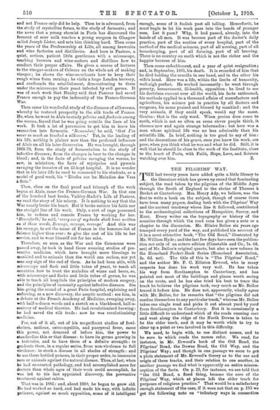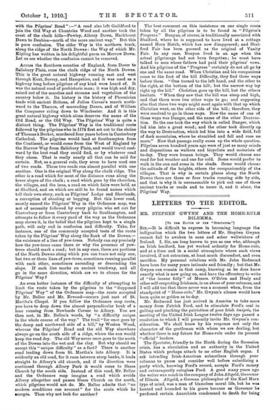THE PILGRIMS' WAY.
last twenty years have added quite a little library to
the literature which has grown up round that fascinating subject, the road taken by the pilgrims of the Middle Ages through the South of England to the shrine of Thomas Becket at Canterbury. Mrs. Henry Ady, we believe, was the first to write a book on the subject, though of course there have been many papers, dealing both with the Pilgrims' Way and the ancient trackway whose line it followed, contributed to the archaeological collections of Hampshire, Surrey, and Kent. Every writer on the topography or history of the counties through which the road runs has given a note or a chapter to the discussion. Mr. Hilaire Belloc six years ago tramped every yard of the way, and published his account of it in a most attractive book, " The Old Road," illustrated by Mr. William Hyde ; and the last few days have seen the publica- tion not only of an octavo edition (Constable and Co., 7s. 6d. net) of Mr. Belloc's original quarto, but also a new volume in the Homeland Pocket-Book Series (Homeland Association, 2s. 6d. net). The title of this is " The Pilgrims' Road," and the author Mr. F. C. Elliston Erwood, who in many respects has done his work very well. He has taken his way from Southampton to Canterbury, and has pointed out most of the buildings and places worth seeing on the route, and he has also tried his best to trace the track he believes the pilgrims took, very much as Mr. Belloc traced it before him. He does not, apparently, wholly agree with Mr. Belloc, for he remarks that "the pilgrims did not confine themselves to any particular track," whereas Mr. Bella,- takes one single road and picks it out almost yard by yard from Southampton to Canterbury. But it is occasionally a little difficult to understand which of the roads running east and west along the ridge of the North Downs is taken to be the older track, and it may be worth while to try to clear up a point or two involved in this difficulty.
We need, to begin with, to use distinct names, W and to be sure to which roads the names refer. We read, for instance, in Mr. Erwood's book of the Old Road, the Pilgrims' Road, the Downs Road, the Old Way, and the Pilgrims' Way ; and though in one passage we seem to get a plain statement of Mr. Erwood's theory as to the use and origin of these tracks, and their relation to one another, in another passage we find what is apparently an entire miscon- ception of the facts. On p. 25, for instance, we are told that "the Old Road, a fixed thing, became the core of the Pilgrims' Way, which at places left the older track for purposes of religious practice." That would be a satisfactory enough statement of the case, if it were not that on p. 183 we get the following note on "tributary ways in connection
with the Pilgrims' Road " :—" A. road also left Guildford to join the Old Way at Chantries Wood and another took the crest of the chalk hills—Pewley, Albury Down, Hackhurst Down to Denbies—north of the more ancient way." But this is pure confusion. The older Way is the northern track, along the ridge of the North Downs : the Way of which Mr. Kipling has written in his delightful poem on Merrow Down. Let us see whether the confusion cannot be removed.
Across the Southern counties of England, from Dover to Salisbury Plain, runs the chalk ridge of the North Downs. This is the great natural highway running east and west through Kent, Surrey, and Hampshire, and it was used as a highway long before pilgrims of any kind were heard of. It was the natural road of prehistoric man; it was high and dry, raised out of the marshes and streams and vegetation of the country below it. Its history is the history of Phoenician trade with ancient Britons, of Julius Caesar's march north- ward to the Thames, of marauding Danes, and of William the Conqueror riding down to Winchester. And it is this great natural highway which alone deserves the name of the Old Road, or the Old Way. The Pilgrims' Way is quite a distinct thing. The Pilgrims' Way is the traditional route followed by the pilgrims who in 1174 first set out to the shrine of Thomas a Becket, murdered four years before in Canterbury Cathedral. The pilgrims would land at Southampton from the Continent, or would come from the West of England by the Harrow Way from Salisbury Plain, and would travel east- ward by the best road they could find, or by whatever road they chose. That is really nearly all that can be said for certain. But, as a general rule, they seem to have used one of two roads. These two roads run almost parallel with one another. One is the original Way along the chalk ridge. The other is a road which for most of the distance runs along the lower slopes of the chalk ; a road which goes by the churches, the villages, and the inns, a road on which fairs were held, as at Shalford, and on which are still to be found names which tell their own story, such as Pilgrims' Lodge and Shoelands, a corruption of shooling or begging. But this lower road, mostly named the Pilgrims' Way in the Ordnance map, was not of necessity followed by every pilgrim who set out for Canterbury or from Canterbury back to Southampton, and attempts to follow it every yard of the way as the Ordnance map shows it, in the belief that the pilgrims kept to a single path, will only end in confusion and difficulty. Take, for instance, one of the commonly accepted tests of the route taken by the Pilgrims' Way along the flank of the Downs,— the existence of a line of yew-trees. Nobody can say precisely how the yew-trees came there or why the presence of yew- trees should mark a road; but in any case, there are portions of the North Downs aloilg which you can trace not only one, but two or three lines of yew-trees, sometimes running parallel with each other, sometimes ascending or descending the slope. If each line marks an ancient trackway, and all go in the same direction, which are we to choose for the Pilgrims' Way ?
An even better instance of the difficulty of attempting to limit the route taken by the pilgrims to the " Supposed Pilgrims' Way" of the Ordnance map—the route accepted by Mr. Belloc and Mr. Erwood—occurs just east of St. Martha's Chapel. If you follow the Ordnance map route, you have to drop down the almost perpendicular bank of a lane running from Newlands Corner to Albury. You are then met, in Mr. Belloc's words, by " a difficulty unique in the whole course of the way." The trail "for once goes by the damp and northward side of a hill," by Weston Wood, whereas the Pilgrims' Road and the old Way elsewhere always go on the south side of a ridge, where the sun would keep the road dry. The old Way never once goes to the north of the Downs into the wet and the clay. But why should we accept this "unique difficulty " as a fact ? There is another road leading down from St. Martha's into Albury. It is evidently an old road, for it runs between steep banks, it leads straight to Albury's old church, and if its direction were continued through Albnry Park it would come to Shere Church by the south side. Instead of this road, Mr. Belloc and the Ordnance map imagine a road which avoids .Albury altogether and passes Shere Church on the north, which pilgrims would not do. Mr. Belloc admits that " no modern conditions can account" for the route which he accepts. Then why not look for another? The best comment on this insistence on one single route taken by all the pilgrims is to be found in " Pilgrim's Progress." Bunyan, of course, is traditionally associated with Shalford, where he is supposed to have lived at a cottage named Horn Hatch, which has now disappeared; and Shal- ford Fair has been guessed as the original of Vanity Fair. In any case, Bunyan lived in an age when the actual pilgrimage had not been forgotten ; he must have talked to men whose fathers had paid their pilgrims' vows. And his pilgrims of the " Progress " certainly do not all go by one and the same road. When Christian and his companions come to the foot of the hill Difficulty, they find three ways before them. "One turned to the left hand, and the other to the right, at the bottom of the hill; but the narrow way lay right up the hill." Christian goes up the hill, but the others hesitate. " When they saw that the hill was steep and high, and that there were two other ways to go ; and supposing also that these two ways might meet again with that up which Christian went, on the other side of the hill ; therefore, they were resolved to go in those ways. Now the name of one of those ways was Danger, and the name of the other Destruc- tion. So the one took the way which is called Danger, which led him into a great wood ; and the other took directly up the way to Destruction, which led him into a wide field, full of dark mountains, where he stumbled and fell and rose no more." Now that passage really sums up the whole question. Pilgrims seven hundred years ago were of just as many minds and dispositions as walkers and bicyclists and motorists of to-day. They were human beings. They would choose one road for hot weather and one for cold. Some would prefer to walk in the sun and some in the shade. Some would choose the solitude of the heights, others the companionship of the villages. That is why in certain places along the North Downs there are three or four tracks running side by side, and that is why it is unreasonable to pick out one of these ancient tracks or roads and to name it, and it alone, the Pilgrims' Way.



























































 Previous page
Previous page